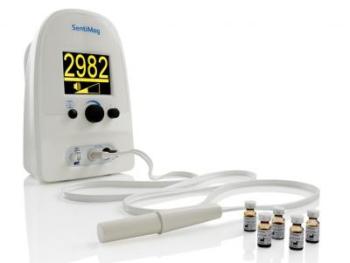Apr 10 2013
A device co-developed by a University of Houston (UH) physicist to detect the spread of breast cancer and allow physicians to better plan intervention is extending its market reach, bringing it another step closer to clinical trials in the U.S.
 The highly sensitive SentiMag instrument and its associated Sienna+ tracer combine nanotechnology and advanced magnetic sensors, removing the need for radiation, speeding up the process and putting the detection of the sentinel lymph node directly in the hands of surgeons. (Photo courtesy of Endomagnetics)
The highly sensitive SentiMag instrument and its associated Sienna+ tracer combine nanotechnology and advanced magnetic sensors, removing the need for radiation, speeding up the process and putting the detection of the sentinel lymph node directly in the hands of surgeons. (Photo courtesy of Endomagnetics)
The SentiMag is a novel intraoperative probe that enables surgeons to more effectively locate the sentinel lymph node – the first lymph node to which a tumor's metastasizing cancer cells drain. The highly sensitive SentiMag instrument and its associated Sienna+ tracer combine nanotechnology and advanced magnetic sensors. Their patented technology removes the need for radiation, speeds up the process and puts the detection of the sentinel lymph node directly in the hands of surgeons.
Co-developed by Audrius Brazdeikis, a research associate professor of physics in the College of Natural Sciences and Mathematics at UH, and his colleagues at the University College of London (UCL), the device has been in use for more than a year in Europe and will now be distributed in the Middle East and Africa. Brazdeikis says approval for use in the U.S. is not far behind.
This most recent development of distribution beyond Europe is the result of an agreement signed between Sysmex Europe GmbH, a leading international company designing and producing diagnostic solutions for medical laboratories worldwide, and Endomagnetics Ltd., a UH spinoff medical devices company. Brazdeikis, who heads the Biomedical Imaging Group at the Texas Center for Superconductivity at UH (TcSUH), formed Endomagnetics with physics professor Quentin Pankhurst and systems engineer Simon Hattersley from UCL to bring their technology to the marketplace.
"The most rewarding aspect in this adventure has been taking our original idea and seeing it through to market introduction," Brazdeikis said. "The biggest challenge wasn't the technology or research or science, but actually developing collaborations across the science and business interface to make this commercialization happen."
Current protocol for locating the sentinel node involves injecting a radioactive isotope several hours before surgery, followed by the surgeon using a highly directional Geiger counter, called a gamma probe, in the operating room to locate the lymph node with the highest radioactivity. Alternately, the SentiMag from Endomagnetics uses a detection system based on magnetics rather than radiation, with the radioactive tracer being replaced by the magnetic nanoparticle tracer and the handheld magnetic sensor replacing the gamma probe.
"This new method requires a surgeon to simply inject the area around a tumor with the Sienna+ nanoparticle, wait 30 minutes for the tracer to accumulate in the lymph nodes and then scan the area of interest using the SentiMag probe to locate the sentinel nodes," Brazdeikis said. "In contrast to the radioactive tracer, a typical magnetic tracer has a shelf life of many months. There are no staff safety issues or disposal of radioactive waste, which lifts regulatory burdens. It also reduces overall cost for the hospital by improving surgery scheduling and, therefore, is more accessible to all patients."
Initially funded by the UK-Texas Bioscience Initiative, the SentiMag system is currently in use in eight European Union countries – the United Kingdom, Germany, Poland, France, Italy, Belgium, Holland and Switzerland. When used together with the injectable Sienna+ nanoparticle, SentiMag gives physicians the ability to better gauge the extent to which cancer has spread.
Sysmex being granted the exclusive right to provide sales and support for this revolutionary system across the European, Middle Eastern and African regions will provide a strong platform for further investment and growth. This is Endomagnetics' first multi-region agreement, and it promises to extend widely the clinical use of the company's technology.
"We are extremely pleased with initial customer feedback," said Eric Mayes, CEO of Endomagnetics. "Partnering with a group as strong as Sysmex gives us the geographic scope and customer support we need to really make an impact."